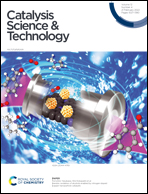Effect of CeO2 morphology on the catalytic properties of Au/CeO2 for base-free glucose oxidation†
Abstract
Catalytic selective oxidation of glucose into value-added gluconic acid is one of the sustainable routes for biomass utilization, for which supported Au catalysts have been widely explored. Au/CeO2 was recently reported as a promising catalyst for glucose oxidation under base-free conditions. However, its catalytic activity needs to be improved with a deep understanding of the catalytic mechanism. Herein, three kinds of CeO2 supports with different shapes (nanorod, nanocube, nanooctahedra) and exposed facets are synthesized, and the interaction between Au and the supports has been intensively investigated. When applied to base-free selective oxidation of glucose to gluconic acid, the Au/CeO2 nanorod (R-CeO2) catalyst delivers the highest catalytic activity with a glucose conversion of 79.6% and gluconic acid selectivity of 100%, due to the strong metal–support interaction and abundant oxygen vacancies. Specifically, the kinetic experiments show that Au/R-CeO2 remarkably lowers the apparent activation energy for glucose oxidation. Moreover, kinetic isotope effect experiments reveal that R-CeO2 accelerates the activation and dissociation of water into surface-active hydroxyls, which promote the glucose oxidation reaction even when the Au particles are poisoned by the large amount of gluconic acid. The results demonstrate the significant influence of CeO2 morphology on the gold catalyst and provide insights into the rational design of high-performance catalysts for glucose oxidation.



 Please wait while we load your content...
Please wait while we load your content...